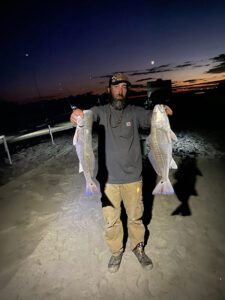Morehead/Atlantic Beach – December 2023
Hank, of Chasin’ Tails, reports that speckled trout fishing has started to fire off, with water temperatures dropping and weather being more consistent. Anglers fishing around the bridges are catching some black drum and sheepshead. Red drum action has been okay, but it’s a bit hit-or-miss as these fish transition into their winter schooling patterns. Nearshore anglers are catching false albacore and bluefish. Runs over to the east side of Cape Lookout are producing king mackerel and some huge wahoo (to 100 lbs.) for the live baiting crowd.
Gulf Stream trips are finding wahoo and a few sailfish. Bottom fishing has mostly consisted of black sea bass, triggerfish, and vermilion snapper. Bluefin tuna have already been seen in the area. For the coldest months, anglers can target speckled trout. These fish will be pushed back up in the creeks, and fishing slowly will be the name of the game. Nearshore structure will hold gray trout and black sea bass, and offshore runs will produce wahoo and the occasional blackfin tuna.

Jack Watson, of Holden Beach, hauled in this 790 lb. bluefin tuna off of Atlantic Beach using live menhaden. He was fishing with Capt. Kevin Sneed of Rigged and Ready Fishing Center.
Joe, of Carolina Traditions Guide Co., reports that nearshore anglers continue to find false albacore, though this whole fall season saw some pretty spotty action. King mackerel anglers are finding a good bite, and they’re also landing the random blackfin tuna (and even wahoo that can be pushed in this time of year). Bottom fishing action remains steady, with black sea bass now starting to move in shallower. Inshore anglers have found strong numbers of sea mullet in deeper holes around the inlet. Speckled trout fishing has been good in the backwaters. These fish haven’t moved all the way back into the creeks and rivers just yet. Some are still staged up on flats waiting until the tide is falling out to feed. Look for red drum to start moving into muddy creeks and bays as they settle into a winter pattern.
Daniel, of On Deck Fishing Charters, reports that inshore anglers have found the speckled trout fishing to be in full swing. Using 1/8 and 1/4 oz. jig heads rigged with an angler’s favorite soft plastic has been a great setup. As these cooler temperatures become the standard, this bite shifts more towards MirrOlures. A live mud minnow under a cork can be another really effective method. Red drum are starting to school up in large groups. On calmer days, this provides some great sight-casting action. The water clarity will be super clear, so anglers need to stay far back from these schools and make longer casts. Nearshore anglers will continue to find good numbers of bluefish and gray trout around structure and in deep holes. Jigging with Z-Man soft plastics or Blue Water Candy Thingamajigs will entice strikes. Bait shrimp on a bottom rig will find sheepshead and black drum at the Cape Lookout jetties.
Chris, of Mount Maker Charters, reports that speckled trout, red drum, sheepshead, and black drum are staged up in their typical colder water spots around structure. Live shrimp under a slip cork has worked well for trout, red drum, and black drum, and Carolina-rigged or jig head-rigged shrimp are enticing strikes from black drum, sheepshead, and red drum. Depending on winds and tides, this action has been found along the ICW, near creek mouths, on marsh points, around oyster rocks, and in deeper holes. Anglers fishing artificials for trout and red drum are having success with soft plastics, hard subsurface lures, and topwater plugs.
Nearshore, there has been an abundance of bluefish in the 1-3 lb. range, with some 4-8 lb. fish in the mix. These schools have been hanging around the inlets, jetties, and shoals. The Cape Lookout jetty is holding speckled trout and red drum, and both species are hitting live shrimp, soft plastics, or hard baits. Moving into winter, start focusing trout efforts on holes in the backs of creeks. Another great winter pastime is bottom fishing for large black sea bass, triggerfish, and vermilion snapper.
Byron, of Going Bogue Outdoors, reports that trolling for wahoo at the break has been a bit sporadic. A good sign, though, is that the king mackerel live-baiting crowd has been landing some of the larger class of wahoo nearshore. Eventually these fish will push back out and setup offshore for anglers making the run. The jumbo black sea bass action has started picking up, with triggerfish and vermilion snapper feeding right beside them. The cooler water temperatures allow for these fish to be pushed in a little shallower than normal. Wintertime also brings the arrival of the giant bluefin tuna fishery. Some sightings of bluefins has happened further south, so hopefully there will be a December push of fish.
Cody, of Reel Time Charters, reports that offshore anglers have their sights set on the wahoo bite. Wahoo have been out in the 180-250’ range and along the Continental Shelf. This bite will be happening through the winter. Also mixed in this area are some chunky blackfin tuna and the occasional sailfish. Bottom fishing has remained strong and is another great option when getting on the boat in the winter.
Triggerfish and vermilion snapper will be staged up in the 100’+ areas. The best black sea bass fishing of the year occurs when it’s cold. These bigger fish move in shallow and are found over structure in the 10-20 mile range. Bri, of Oceanana Pier, reports that a bunch of black drum are being caught, with the evening and nighttime hours best, and anglers are starting to see some mixed-sized puffers showing up.






